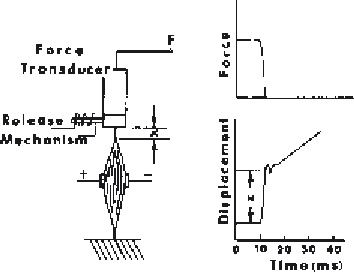Biomedical Engineering Reference
In-Depth Information
Figure 9.11
Experimental arrangement to determine the spring constant of the series
elastic element. Muscle is stimulated; after the tension builds up in the muscle, the
release mechanism activates, allowing an almost instantaneous shortening,
x
, while the
force change is measured on a force transducer.
repeated for another force level until a force-shortening curve can be plot-
ted. During the rapid shortening period (about 2 ms), it is assumed that the
contractile element has not had time to change length, even though it is still
generating tension. Two other precautions must be observed when conducting
this experiment. First, the isometric length prior to the release must be such
that there is no tension in the parallel elastic element. This will be so if the
muscle is at resting length or shorter. Second, the system that records the
sudden shortening of the series elastic element must have negligible mass
and viscosity. Because of the high acceleration and velocity associated with
the rapid shortening, the resisting force of the attached recording transducer
should be negligible. If such conditions are not possible, a correction should
be made to account for the mass or viscosity of the transducer.
9.1.4 In Vivo Force-Length Measures
Length-tension relationships of striated muscle have been well researched
in mammalian and amphibian species, but in humans the studies have been
limited to changes in joint moments during maximum, voluntary contraction
(MVC) as the joint angle is altered. Two problems arise in such studies. First,
it is usually impossible to generate an MVC for a single agonist without
activating the remaining agonists. Thus, the joint moment is the sum of the
moments generated by several agonists, each of which is likely to be operating
at a different point in its force-length curve. Also, the moment generated by
any muscle is a product of its force and its moment arm length, both of which
change as the joint angle changes. Thus, any change in joint moment with
joint angle cannot be attributed uniquely to the length-tension characteristics
of the muscle.










Search WWH ::

Custom Search